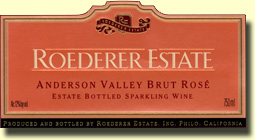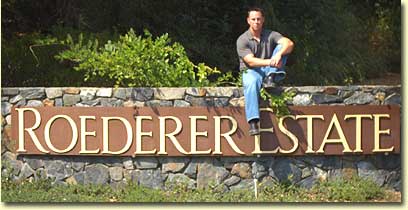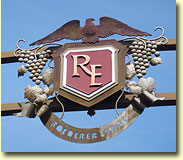The second reason Roederer bought Scharffenberger was to make them a US version
of
Deutz. Roederer had great success raising the quality of Deutz in Champagne and
making money from the deal. They are looking to duplicate that with
Scharffenberger right down to the tasting rooms. At Roederer Estate
there are write-ups and displays on Louis Roederer Champagne and you can
buy Louis Roederer’s complete line-up there. At Scharffenberger, this
same format is followed except that it is Deutz that is highlighted.
Roederer has said that they intend to keep Scharffenberger as a
completely different style of wine, but would like to raise the quality.
As for Roederer, they are kicking along as a high quality producer, but
I think they are having some quality problems, as the demand for their
wine is high and as mentioned above, they only use estate grown fruit.
In my opinion, this has caused a few of the NV wines to be released a
little too soon and take on green notes. Across multiple bottles, I
noticed that both the NV White and Rosé Bruts have been uneven. I think
time will help it, but I also think that the drop in time spent lees
aging will end up costing the wines a bit of future complexity. Outside
of this, the wines are well made and the most Champagne-like of any of
the California sparklers. This is my only other argument with Roederer
Estate. It is clear that Roederer has top fruit and a great team, but I
think they spend a bit too much effort embracing Champagne and not
enough embracing California. I think adding in a slight bit more
California style would lift the wines up even more. It is a minor
complaint, but I’ve always found that tilting too much towards
California or Champagne can stunt the full potential of what could be
accomplished. This is seen in the fact that a common characteristic of
the Roederer Estate L’Ermitage vintages as they age is something that I
call “slippery citrus”. It is kind of a funky early maturing citrus
flavor that I find in sparkling wines (from anywhere) that are trying to
be something they are not; in this case, Champagne. I do not know what
causes it, but it is not a plus, though in small amounts is only a
minor defect in my eyes. However, when it really stands out, it is a
huge defect and can develop into a yucky, slimy citrus flavor. All of
the L’Ermitage cuvees from 1996 and before showed this in at least a
minor way with the 1993 really showing it.
Regardless of any criticism I level on Roederer Estate, it is one of the
best sparkling wine producers not only in California, but in the world.
I just see potential to be even better.
Some quick facts/thoughts/opinions on Roederer Estate:
-
The Roederer Estate Brut is 70%
Chardonnay and 30% Pinot Noir with at least 2 years of aging on its
lees. The cuvee includes 11-15% of reserve wines which were oak
aged.
-
The Roederer Estate Rosé is
60% Pinot Noir and 40% Chardonnay with at least 2 years aging on its
lees. The rosé is made by a 5% addition of red wine. 10-20% of the
cuvee is made up of oak aged reserve wines. This bottling is
actually produced in lower numbers than the L’Ermitage Brut (but not
the L’Ermitage Rosé).
-
L’Ermitage is normally around
50/50 Chardonnay and Pinot Noir with a slight majority of
Chardonnay; Even though it is vintage dated, it includes a few
percent of oak aged reserve wines. The base of the dosage for this
wine is a previous vintage’s L’Ermitage base wine aged in oak casks.
-
The Roederer Estate Extra Dry is
a higher dosed version of the Roederer Estate Brut.
-
Dosage levels on the wines are in
the 11-13 g/L range with 12 g/L being the norm.
-
All Roederer Estate sparklers are
made from estate grown fruit.
-
L’Ermitage is normally disgorged
anywhere around 3-3.5 years after it is put in the bottle for second
fermentation (add on an extra 6 months to the 3 years to date back
to harvest.
-
Magnums are aged a minimum of 1
extra year on their lees vs. 750 mL bottles (as is the practice at
many producers).
-
I did not taste the L’Ermitage
Rosé. The L’Ermitage Rosé is made by the red wine addition method
and follows the dosage of the other brut wines (which follow the
Louis Roederer dosage tendencies) and is at 12 g/L for the first
release in 1999. As with the regular L’Ermitage it is around 50/50
Chardonnay and Pinot Noir with a slight majority of Pinot Noir. It also
includes a small percentage of oak aged reserve wine and has a
dosage based on a prior vintage of L’Ermitage. Basically, this is
the L'Ermitage with some still Pinot Noir added to it... and an
extra $30-$35 added to the price tag.
-
I really think most Roederer
Estate wines need some bottle age after purchase to reach their full
potential. A minimum of 1 year for the NV wines and 3+ years for
L’Ermitage.
As with many other California
winemakers, I think all the Roederer wines would be better with an extra
year spent aging on the lees. The proof is in the tasting. I wish
economics weren’t an issue and this could be done. Please note that I
don’t think you should age sparkling wine on its lees for as long as you
can, but many new world sparkling wine producers age their wines far too
young for how they have crafted their cuvees.
As with all my other California notes, these wines were tasted between
September 12 and October 15 of 2006. They came from the following
sources: purchased at the winery, supplied by the winery, tasted at the
winery, new releases purchased from a store, and older vintages from my
cellar. Some of the wines were tried multiple times and almost all were
evaluated over a minimum of a 1 hour period. Glassware was not
consistent. With any older bottle, bottle variation can run high. When a
bottle was clearly flawed and there was no backup, I have noted it. I
have had many of these wines (and others not included below) before and
that has helped in shaping a perspective for when a wine is dying and
was not flawed.
Roederer Estate Wines
NV Brut
Fresh peaches, citrus, and honeysuckle on the nose with flavors of
fresh squeezed citrus juice and toast. I tasted quite a few bottles of
this and some were a bit green and clearly needed time. The magnums show
a bit more fruit oomph and maturity to them. I like the wine, but my
only complaint is that sometimes bottles seem to be released a bit too
young when compared to a couple years ago. I would encourage storage
of at least a year unless you are into variation. Or, you could just buy
magnums. B Find this wine
 NV Brut Rose
NV Brut Rose
I love the strawberries, biscuits, and citrus cream that weave their way
through the nose and palate, but I wish it had a bit more depth or
power. This has the potential to be one of the top couple of California
sparklers, but always seems just a bit too thin to get there.
B
Find this wine
NV Extra Dry
A higher dosed version of the regular Brut. This shows a candied nose
and a light, fluffy palate with sweet pears and citrus. Not bad, but I
prefer the Brut. B- Find this wine
1990 L’Ermitage
Biscuit spice, bland citrus, and pears make up the wine mix. The typical
cream also enters in. I would drink this up as it seems to be fading a
bit . B- Find this wine
1991 L’Ermitage
This is still kicking with plenty of citrus and creamy yellow apples on
the nose. The palate is no slacker either, with allspice and honey
highlighting a slightly sweet biscuit, pear, and citrus parade.
B+ Find this wine
1992 L’Ermitage
Creamy, candied, pie crust on the nose leads into a fluffy palate that
is highlighted by graham crackers, peaches, and pears. This is showing a
strong sweetness that I think holds it back just a bit and costs it a
higher grade. That said, it is the most exotic of the L’Ermitages I
tasted. High B+ Find this wine
1993 L’Ermitage
This is very creamy and dominated by citrus. The downfall is that the
citrus seems to be going over and getting a tad slippery (you can really
pick up on this as the wine warms up). Some oxidation is sneaking in. It
does show good apple and pear fruit, but this bottle stood a rung below
its peers due to the predominance of the slippery citrus flavor. Maybe a
bit of bad storage or heat damage brought the slippery citrus more to
the fore on this bottle? High
B Find this wine
1994 L’Ermitage (disgorged October 1999)
A honey-kissed and floral spiced biscuit nose greets me with a warm hug.
It then shows off its rich, creamy body with a note of sweetness and
serves me a side of Crème Brûlée. For an encore, this beautiful wine
covers itself in baked apples, citrus, biscuits, and pie crust. I’m in
love. One of the best wines I tasted during my adventure. If you think
this is good out of the bottle, try it out of magnum (I didn’t taste it
out of magnum for this note, but the mags have been knockouts in the
past). One interesting note about this wine: because there was no 1995,
this wine was released and disgorged across a couple years. Because of
this, many bottles saw extra time aging on their lees when compared to
other vintages of L’Ermitage. I think this helped add to the quality of
the 1994 vintage especially if you drink one of the late disgorged
bottles. I’ve had this out of bottles disgorged in 1998 and out of magnum.
It has always been an A- wine with the magnums and 1999 disgorgements
showing up at a higher A- level.
High A- Find this wine
1996 L’Ermitage (disgorged April 2000)
A spicy, honey citrus nose with excellent doughy notes. The palate shows
gorgeous flavors of baking spice, apples, cream, and biscuit. It is an
apple pie in a bottle and gets better with air.
A- Find this wine
1997 L’Ermitage
Tart citrus and doughy notes with highlights of peaches and pears
dominate the profile of this wine. It shows an out of place fluffiness
and a finish that is a little short. This stands out as having excellent
potential, but isn’t quite there yet. As the bottle sat open, this
improved quite a bit. Low B+ with the potential to
become a very solid or high B+ Find this wine
1998 L’Ermitage
Corked! No backup!! I located some at a local shop and they informed me
that they had bottles, but that they were cooked!!! I guess I was not
meant to taste this wine right now.
1999 L’Ermitage
Very smooth and creamy with young dough and citrus blossoms weaving in
and out of the nose and palate. This is very clean and has a nice toasty
finish. Will improve with time, but stay in the B+ zone.
B+ Find this wine
Some quick facts/thoughts/opinions on
Scharffenberger/Pacific Echo:
-
The Scharffenberger Brut is 67%
Pinot Noir and 33% Chardonnay with a dosage of 9-12 g/L
-
The Scharffenberger Extra Dry is
identical to the Brut except that it has a dosage of 20 g/L
-
The makeup of the Cremant is very
similar to the above wines only with a slight bit more Chardonnay.
The dosage is 28 g/L.
-
All wines see 100% malolactic
fermentation. If there is one change Roederer makes, I hope it is
this.
-
They will be bringing out a Rosé
in the coming year. No decisions on vintage dated cuvees have been
made yet. Roederer appears to be taking a wait and see approach.
-
The one thing to remember is that
Tex Sawyer has led winemaking going back to the original
Scharffenberger label and I have not seen any changes through the
years of transition. So, regardless of the label, what is in the
bottle is consistent. We will have to wait and see if the Roederer
control changes things.
Scharffenberger/Pacific Echo Wines
NV Scharffenberger Brut
Very easy to drink with lots of apple notes, but nothing else stands
out. A very ordinary and inoffensive wine, but also a very yawn inducing
wine. C+ Find this wine
NV Scharffenberger Extra Dry
Same wine as the Brut only with a higher dosage. I think the dosage
helps it out here as this is a bit lighter and fluffier with powdered sugar and peaches joining the apple profile and giving it some
expression. B- Find this wine
NV Scharffenberger Cremant
Mucho malo on the nose. Both the nose and palate are a bit thin and
light. I like the way the lightness matches with the very sweet flavors,
but the only fruit present is clumsy fat apple.
Low C Find this wine
NV Pacific Echo Cremant
Simple aromas of shriveled (but not yet moldy) peaches, sugar, and
flowers. Not very attractive. The taste is bitter and has flavors of
sugary, spoiled peach juice mixed with some flowers and watered down
Budweiser. Very odd. I do not like this.
D+ Find this wine
1997 Pacific Echo Brut Rosé
Ripe citrus and tart red berries mix with a good serving of biscuits to
lead a nice nose into a biscuit filled palate. Joining the biscuits are
strawberries and red citrus. The finish is short and this is starting to
fade so drink up if you have it. B- Find this wine
And, since this Scharffenberger is a kind of “US Deutz”, I thought I
would throw in this tasting note from when Deutz had their own US
operation (joint venture between Beringer and Deutz). It was my last
bottle. No tears were shed.
1990 Maison Deutz
A mature golden color highlights this wine. I’ve noticed that many
California sparklers not only mature faster in flavor, but also in
color. I wonder why? The nose on this wine is citrus and sherry. The
palate is full of thin slippery citrus, dry sherry, and toasty notes. It
is clearly oxidized, but interesting, as it isn’t made anymore and
harkens back to a time when everyone in Champagne and their brother were
starting California sparkling wineries. This is a wine on its last
legs or dead already and as so, I won’t grade it (though it was never
very good in its prime). If you want to make a grade up for it, you
could use any of the last 23 letters of the alphabet and I wouldn’t
argue with you.
__________________
Brad Baker
California Sparklers
Intro | Iron Horse |
Carneros
BACK TO
THE TOP
BACK
TO BRAD BAKER'S INDEX PAGE
© Brad Baker
 Link
to Gang of Pour Home Page
Link
to Gang of Pour Home Page
 Link
to Gang of Pour Site Index (Table of Contents)
Link
to Gang of Pour Site Index (Table of Contents)





 Roederer bought Scharffenberger for a couple of reasons. No matter what
you hear, the biggest one was to get more land to increase Roederer
Estate production. Scharffenberger owned 275 hectacres (not all of it
is planted) and Roederer was looking to expand Roederer Estate
production, but only uses estate grown Anderson Valley Fruit. How do you
get more estate fruit? You buy another vineyard. This means that more
and more of the fruit that goes into Scharffenberger will be brought
in
(confirmed by Roederer and Scharffenberger). Is this bad? I don’t think so,
as I never really liked Scharffenberger/Pacific Echo. As long as Roederer raises the quality, I don’t care. My first thought was that
Roederer would simply keep the land and sell the label and stocks of
Scharffenberger, but they do not plan on doing this.
Roederer bought Scharffenberger for a couple of reasons. No matter what
you hear, the biggest one was to get more land to increase Roederer
Estate production. Scharffenberger owned 275 hectacres (not all of it
is planted) and Roederer was looking to expand Roederer Estate
production, but only uses estate grown Anderson Valley Fruit. How do you
get more estate fruit? You buy another vineyard. This means that more
and more of the fruit that goes into Scharffenberger will be brought
in
(confirmed by Roederer and Scharffenberger). Is this bad? I don’t think so,
as I never really liked Scharffenberger/Pacific Echo. As long as Roederer raises the quality, I don’t care. My first thought was that
Roederer would simply keep the land and sell the label and stocks of
Scharffenberger, but they do not plan on doing this.
 NV Brut Rose
NV Brut Rose